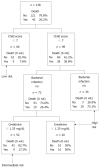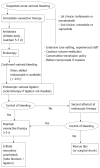Acute esophageal variceal bleeding: Current strategies and new perspectives
- PMID: 21161008
- PMCID: PMC2998973
- DOI: 10.4254/wjh.v2.i7.261
Acute esophageal variceal bleeding: Current strategies and new perspectives
Abstract
Management of acute variceal bleeding has greatly improved over recent years. Available data indicates that general management of the bleeding cirrhotic patient by an experienced multidisciplinary team plays a major role in the final outcome of this complication. It is currently recommended to combine pharmacological and endoscopic therapies for the initial treatment of the acute bleeding. Vasoactive drugs (preferable somatostatin or terlipressin) should be started as soon as a variceal bleeding is suspected (ideally during transfer to hospital) and maintained afterwards for 2-5 d. After stabilizing the patient with cautious fluid and blood support, an emergency diagnostic endoscopy should be done and, as soon as a skilled endoscopist is available, an endoscopic variceal treatment (ligation as first choice, sclerotherapy if endoscopic variceal ligation not feasible) should be performed. Antibiotic prophylaxis must be regarded as an integral part of the treatment of acute variceal bleeding and should be started at admission and maintained for at least 7 d. In case of failure to control the acute bleeding, rescue therapies should be immediately started. Shunt therapies (especially transjugular intrahepatic portosystemic shunt) are very effective at controlling treatment failures after an acute variceal bleeding. Therapeutic developments and increasing knowledge in the prognosis of this complication may allow optimization of the management strategy by adapting the different treatments to the expected risk of complications for each patient in the near future. Theoretically, this approach would allow the initiation of early aggressive treatments in high-risk patients and spare low-risk individuals unnecessary procedures. Current research efforts will hopefully clarify this hypothesis and help to further improve the outcomes of the severe complication of cirrhosis.
Keywords: Complications of cirrhosis; Portal hypertension; Variceal bleeding.
Figures


Similar articles
-
Current approaches to the management of patients with liver cirrhosis who have acute esophageal variceal bleeding.Curr Med Res Opin. 2016;32(3):467-75. doi: 10.1185/03007995.2015.1124846. Epub 2016 Jan 25. Curr Med Res Opin. 2016. PMID: 26804426 Review.
-
Acute variceal bleeding.Semin Respir Crit Care Med. 2012 Feb;33(1):46-54. doi: 10.1055/s-0032-1301734. Epub 2012 Mar 23. Semin Respir Crit Care Med. 2012. PMID: 22447260 Review.
-
Medical management of variceal bleeding in patients with cirrhosis.Can J Gastroenterol. 2004 Feb;18(2):109-13. doi: 10.1155/2004/560215. Can J Gastroenterol. 2004. PMID: 14997222 Review.
-
[Mexican consensus on portal hypertension].Rev Gastroenterol Mex. 2013 Apr-Jun;78(2):92-113. doi: 10.1016/j.rgmx.2013.01.006. Epub 2013 May 9. Rev Gastroenterol Mex. 2013. PMID: 23664429 Spanish.
-
Variceal bleeding : pharmacological treatment and prophylactic strategies.Drugs. 2008;68(16):2303-24. doi: 10.2165/0003495-200868160-00004. Drugs. 2008. PMID: 18973395 Review.
Cited by
-
Just-in-time clinical video review improves successful placement of Sengstaken-Blakemore tube by emergency medicine resident physicians: A randomized control simulation-based study.AEM Educ Train. 2021 Feb 16;5(3):e10573. doi: 10.1002/aet2.10573. eCollection 2021 Jul. AEM Educ Train. 2021. PMID: 34124519 Free PMC article.
-
Predictive Value of a Noninvasive Serological Hepatic Fibrosis Scoring System in Cirrhosis Combined with Oesophageal Varices.Can J Gastroenterol Hepatol. 2018 Aug 14;2018:7671508. doi: 10.1155/2018/7671508. eCollection 2018. Can J Gastroenterol Hepatol. 2018. PMID: 30186822 Free PMC article.
-
Real-world comparison of terlipressin vs. octreotide as an adjuvant treatment in the management of variceal bleeding.Sci Rep. 2024 Mar 20;14(1):6692. doi: 10.1038/s41598-024-56873-x. Sci Rep. 2024. PMID: 38509184 Free PMC article. Review.
-
Esophageal Stent in Acute Refractory Variceal Bleeding: A Systematic Review and a Meta-Analysis.J Clin Med. 2024 Jan 9;13(2):357. doi: 10.3390/jcm13020357. J Clin Med. 2024. PMID: 38256491 Free PMC article. Review.
-
Predictors of in-hospital mortality in a cohort of elderly Egyptian patients with acute upper gastrointestinal bleeding.Medicine (Baltimore). 2018 Apr;97(16):e0403. doi: 10.1097/MD.0000000000010403. Medicine (Baltimore). 2018. PMID: 29668596 Free PMC article.
References
-
- Graham DY, Smith JL. The course of patients after variceal hemorrhage. Gastroenterology. 1981;80:800–809. - PubMed
-
- Gines P, Quintero E, Arroyo V, Teres J, Bruguera M, Rimola A. Compensated cirrhosis: natural history and prognostic factors. Hepatology. 1987;7:122–128. - PubMed
-
- El-Serag HB, Everhart JE. Improved survival after variceal hemorrhage over an 11-year period in the Department of Veterans Affairs. Am J Gastroenterol. 2000;95:3566–3573. - PubMed
-
- Augustin S, Muntaner L, Altamirano JT, González A, Saperas E, Dot J, Abu-Suboh M, Armengol JR, Malagelada JR, Esteban R, et al. Predicting early mortality after acute variceal hemorrhage based on classification and regression tree analysis. Clin Gastroenterol Hepatol. 2009;7:1347–1354. - PubMed
LinkOut - more resources
Full Text Sources
Other Literature Sources

